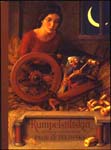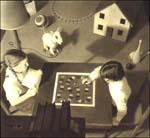Elements of Design - Part II
D. Space
The way an illustrator uses space is another tool for evoking certain emotions. When an illustrator leaves a white border around the illustration, we say the picture is framed. When the illustration stretches to the edges of the paper, we say the illustration bleeds. A frame can provide a sense of distance -- you are looking at something that isn't in the same space as you are. Illustrations that are framed appear to extend beyond the page and thus feel more immediate. Sometimes illustrators break the frame and the effect is three-dimensional, making it appear that objects are coming out of the page.
Look at this image from Yoko's Paper Cranes.

Here you can see Rosemary Wells has framed her picture with a wide margin of white page, and then a border that boxes off the illustration and the text. She breaks the border with cranes flying out of the verso picture and into the recto. This gives the picture a sense of depth and suggests that the picture may continue beyond the edges of the book.
Look also at how Trina Schart Hyman provides a windowpane-like border around the dragon in St. George and the Dragon.
![]() Go to the Web Resources link for Saint George and the Dragon to see images and
get more information.
Go to the Web Resources link for Saint George and the Dragon to see images and
get more information.
This has the effect of distancing the reader from the picture. You are aware you are watching, but you are not part of the action.
Lane Smith breaks the frame repeatedly in The True Story of the Three Little Pigs. In one picture, we see a pig and part of the stick house being blown off the page. In the last picture in the book we see the wolf asking for a cup of sugar, and the cup he is holding is breaking the frame. The effect is that the picture looks three-dimensional.
![]() Look at your copy
of The True Story of the Three Little Pigs to see this demonstrated.
Look at your copy
of The True Story of the Three Little Pigs to see this demonstrated.
Sometimes artists are able to work the color of the page into the picture. The term for this is negative space. John Steptoe does this effectively in Mufaro's Beautiful Daughters, by having the white of the page become part of the gown of one of the young women. You were not required to purchase this book; take a moment to visualize the concept.
Books such as David Macaulay's Black and White make considerable use of negative space.
![]() Go to the Web Resources link for Black and White to see images and
get more information.
Go to the Web Resources link for Black and White to see images and
get more information.
Take a look at this illustration from Zelinsky's Rumpelstiltskin.

We can see, large in the foreground, the queen and her baby with Rumpelstiltskin in the background. The larger the object, the more it commands our attention, so our eye is immediately drawn to the Queen and baby. The picture has a flowing rhythm to it. The Queen and baby are on the left side of the picture, the place on the page where we, as English speakers, expect the story to begin. Your eye moves from left to right, noticing Rumpelstiltskin in the background at the far right side, the precise place where you would grab the page to turn it.
Sometimes illustrators work against this left-to-right flow. An example would be an illustration from Snow White in New York in which Snow White is singing and the newspaper reporter is listening to her. The reporter is in the foreground on the right-hand (recto) side of the page and is looking back left at Snow White, who is in the background on the left (verso) side of the page. This design forces the eye from right to left, or against the flow. Likewise, we later see the wicked stepmother in the foreground on the right side of the page and Snow White in the background on the left side. The effect to make your eye stop and go back to the left, thus creating a pause in the rhythm of the book.
![]() Be sure to look
at your copy of Snow White in New York to see this demonstrated.
Be sure to look
at your copy of Snow White in New York to see this demonstrated.
E. Point-of-View / Perspective
Finally, illustrators can manipulate how you feel by the perspective they choose to show the picture. Perspective refers to techniques used to create the illusion of three dimensions on a two-dimensional piece of paper. A linear perspective creates the sensation of depth or distance through the use of converging lines. Again, look at Zelinsky's Rumpelstiltskin.


Aerial perspective involves modulating color to suggest atmospheric effects. Check out the horizon on the title page from When Sheep Cannot Sleep. Kitamura has used red, orange, yellow, white, and blue to create a night sky that seems calm, an appropriate feeling for a bedtime book.
![]() Be sure to look
in your copy of When Sheep Cannot Sleep to see this concept demonstrated.
Be sure to look
in your copy of When Sheep Cannot Sleep to see this concept demonstrated.
Point-of-view refers to the position from which you see the objects in the picture. Providing a straight-on look suggests a kind of equality between the illustrator and the viewer. A low point-of-view makes the viewer feel lower than the picture and less powerful. A high perspective looks down upon the action and makes the reader feel more powerful. John Showenherr uses shifting points-of-view effectively in Owl Moon to convey action. You were not required to purchase this book; take a moment to visualize the concept.
Chris Van Allsburg uses a high point-of-view in Jumanji to suggest we can feel superior to the children who are playing the game. Later in the story, a lower point-of-view makes the stampeding rhinos seem all the more dangerous.

